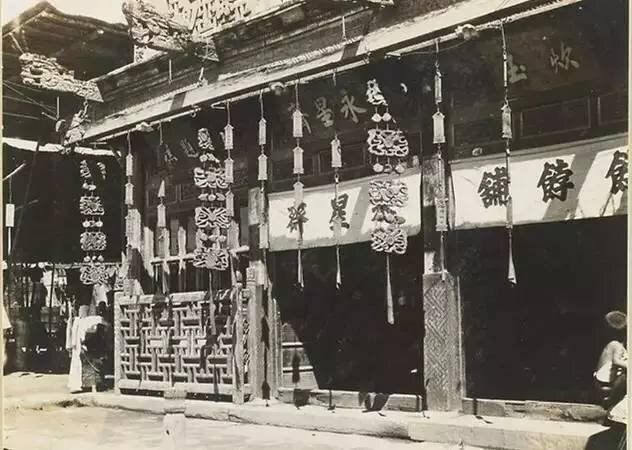Old Beijing Shop Signs Tea Towels - the Code Language of the Capital
We recently stumble upon the fascinating forest of Qing dynasty shop signs, that originally dangled outside shop fronts in the dusty streets of Beijing.
The shopfront of Yong Xing Zhai, a famous manchus’ bakery
In the National Museum of Denmark a hand drawn album of these shop symbols by an artist named Zhou Peichun is preserved. This unknown painter created the album as one of the first Beijing souvenirs ever produced.
Today, branding is often universal. The signs of certain burger joints can be spotted and easily recognized all over the world. But only a hundred years ago, when Chinese people from the south of the country arrived in Beijing, they did not have a clue what was sold inside Beijing’s shops. This was because the signage outside the stores was particular to Beijing. You could almost call it a code of the capital. Many of the shop signs did not have any Chinese characters on them, because most people did not know how to read.
When tourism began to develop in Beijing after the establishment of the legation quarter and foreign missions in 1862, books with hand colored shop signs became popular as a souvenir. Arriving in the capital, many Western travelers were almost a little disappointed in the city. They felt that all of the architecture in the grey hutong alleyways looked the same, but the shop symbols stood out. They came in all conceivable shapes and colours, so it was not so weird that this was what they wished to remember from their visit and display when they arrived back in their native countries.
The old shop sign of the Ji An Zhai's pharmacy is still hanging outside Wang Xiu Ren’s shop front today
Our neighbor Wang Xiuren’s family has been living in our street for around 400 years. They originally produced a kind of medicine called Goupigaoyao (which can roughly be translated to “dogskin Band-Aid”) and even though they don’t produce the medicine any more they are very proud of the family history and have created a small display with some of the artefacts dating all the way back to the Qing dynasty.
One of the artists that produced these books with hand coloured shop signs was named Zhou Peichun. He was originally from Beijing, but for many years lived thousands of kilometers away in Guangzhou, where he specialized in painting pictures for the foreign - especially Western - community. When the Western powers won the right to open embassies in the capital of China in the early 1860s, Zhou Peichun followed his customers back to his native Beijing.
Today, while his albums with hand painted shop signs can be found in many libraries all over the world, almost none of the signs he painted remain in the streets of Beijing. However, by chance, we realized whilst carrying out this research that only around a hundred meters from our gallery, you still have an original Beijing shop sign dangling in the wind.
Zhou Peichun’s album of Old Beijing Shop Signs
The Beijing shop signs are alleged to have disappeared due to three main reasons. In the 1930s, the city government apparently started to tax the shops according to their signs. This prompted a lot of businesses to simply take them down. Another reason was the creation of a Chinawide, even globalized, market. Advertisement aimed to create generic signs that could be immediately recognized by the whole country. But maybe the most important reason for their disappearance was the introduction of western style shop windows, which meant people could know what was sold inside the shop just from glancing through a window, rendering the signs useless.






